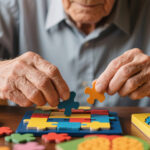Introduction
Sundown syndrome, often referred to as “sundowning,” is a common and distressing phenomenon experienced by individuals with dementia. It manifests as increased confusion, anxiety, agitation, and other behavioral changes that begin in the late afternoon or early evening and can continue into the night. This period of heightened distress can be incredibly challenging for both the person living with dementia and their caregivers, disrupting sleep patterns, increasing stress, and impacting overall quality of life. Understanding sundown syndrome is the first step toward effectively managing its symptoms and providing a more peaceful environment for those affected.
This comprehensive guide aims to shed light on sundown syndrome, exploring its potential causes, identifying common triggers, and offering practical, empathetic strategies for management. Our goal is to empower families and caregivers with the knowledge and tools necessary to navigate this complex aspect of dementia care, fostering a sense of calm and stability during these difficult hours. By adopting a proactive and compassionate approach, it is possible to mitigate the severity of sundowning episodes and improve the well-being of dementia patients.
What is Sundown Syndrome?
Sundown syndrome is not a disease in itself but rather a collection of neuropsychiatric symptoms that occur in individuals with dementia as daylight fades. The term “sundowning” aptly describes this temporal pattern, where symptoms typically worsen as the sun sets. These symptoms can vary widely among individuals but commonly include increased confusion, disorientation, anxiety, agitation, restlessness, pacing, yelling, suspiciousness, and even hallucinations or delusions. For some, it might manifest as a sudden burst of energy, while for others, it could be profound sadness or fear.
It is estimated that up to 20% of individuals with Alzheimer’s disease and other forms of dementia experience sundowning. The exact mechanisms behind sundown syndrome are not fully understood, but it is believed to be a multifactorial phenomenon involving disruptions to the brain’s internal clock (circadian rhythm), changes in light exposure, fatigue, and an inability to process environmental stimuli as effectively. The transition from day to night can be particularly disorienting for someone with cognitive impairment, leading to heightened anxiety and a sense of unease.
Potential Causes and Contributing Factors
The onset and severity of sundown syndrome are influenced by a combination of physiological, psychological, and environmental factors. Identifying these potential causes can help caregivers tailor interventions more effectively.
Disruption of Circadian Rhythms
One of the primary theories behind sundowning involves the disruption of the body’s natural sleep-wake cycle, or circadian rhythm. The suprachiasmatic nucleus (SCN) in the brain, which regulates circadian rhythms, can be damaged in individuals with dementia. This damage can lead to irregular melatonin production, making it difficult for the person to distinguish between day and night. As natural light diminishes, the brain may struggle to adjust, leading to confusion and agitation.
Fatigue and Overstimulation
By late afternoon, individuals with dementia may experience increased fatigue, both physical and mental. The effort required to process information and navigate their environment throughout the day can be exhausting. This accumulated fatigue can lower their tolerance for stress and make them more susceptible to agitation. Conversely, an environment that is too stimulating during the day, with excessive noise, activity, or visitors, can also contribute to overstimulation, leading to a “meltdown” as evening approaches.
Changes in Light and Shadows
The diminishing natural light and increasing shadows in the late afternoon can be particularly unsettling for dementia patients. Their impaired cognitive abilities may cause them to misinterpret shadows as threatening figures or objects, leading to fear and paranoia. The change in lighting can also make it harder for them to see and understand their surroundings, increasing disorientation and anxiety.
Hunger, Thirst, and Discomfort
Basic physiological needs can often be overlooked or uncommunicated by individuals with dementia. Hunger, thirst, pain, a full bladder, or discomfort from clothing or temperature can all contribute to restlessness and agitation. As cognitive function declines, the ability to express these needs clearly diminishes, leading to behavioral expressions of distress.
Medication Side Effects
Certain medications, particularly those taken in the evening, can have side effects that exacerbate sundowning symptoms. Some drugs can cause drowsiness, confusion, or restlessness. It is crucial for caregivers to review all medications with a healthcare professional to ensure they are not contributing to the problem.
Environmental Factors
The home environment itself can play a significant role. A chaotic or unfamiliar environment can increase anxiety. Changes in routine, moving to a new place, or even the presence of unfamiliar people can trigger sundowning. The absence of familiar cues as evening approaches can also contribute to a sense of loss and confusion.
Recognizing the Signs of Sundown Syndrome
Early recognition of sundowning symptoms is vital for effective management. While the specific manifestations can vary, common signs include:
Increased Confusion and Disorientation: The individual may ask repetitive questions, not recognize familiar people or places, or seem generally lost. Agitation and Restlessness: Pacing, fidgeting, an inability to sit still, or verbal outbursts are common. Anxiety and Fear: The person may express feelings of fear, worry, or unease, sometimes without a clear cause. Suspiciousness or Paranoia: They might accuse caregivers of stealing or harming them, or believe people are watching them. Hallucinations or Delusions: Seeing or hearing things that aren’t there, or holding onto false beliefs. Aggression: In some cases, agitation can escalate to verbal or physical aggression. Wandering: An urge to leave the house or go somewhere, often without a clear destination. Demanding Behavior: Repeatedly asking for things, attention, or to go home.
These behaviors typically begin in the late afternoon or early evening and may subside as the night progresses, only to reappear the next day. Keeping a log of when these behaviors occur and what might have preceded them can help identify patterns and triggers.
Effective Strategies for Managing Sundown Syndrome
Managing sundown syndrome requires a multi-faceted approach that combines environmental adjustments, behavioral interventions, and sometimes, medical considerations. The key is to identify individual triggers and implement strategies that promote comfort, security, and a sense of routine.
1. Establish a Consistent Daily Routine
Consistency is paramount for individuals with dementia. A predictable daily schedule can help orient them and reduce anxiety. Try to maintain regular times for waking, meals, activities, and bedtime. This helps reinforce the body’s natural circadian rhythm. Schedule demanding appointments or activities, such as doctor visits or bathing, earlier in the day when the person is typically more alert and less agitated. [1]
2. Optimize the Environment
The physical environment plays a crucial role in managing sundowning. As evening approaches, make conscious efforts to create a calm and well-lit space:
Increase Lighting: As natural light fades, turn on lights early to minimize shadows, which can be disorienting and frightening. Consider using full-spectrum lighting to mimic natural daylight. Close curtains or blinds to block out confusing shadows from outside. [2] Reduce Noise and Clutter: Minimize excessive noise and visual clutter, especially in the evening. Turn off televisions or radios if they are not actively being watched or listened to. Create a quiet, peaceful atmosphere. Ensure Safety: Make sure the environment is safe, especially if wandering is a concern. Remove tripping hazards and secure exits if necessary.
3. Engage in Meaningful Daytime Activities
Encourage physical activity and engagement during the day to promote better sleep at night and reduce restlessness in the evening. This could include walks, light exercise, or engaging in hobbies they enjoy. However, avoid overstimulation, especially in the late afternoon. Balance activity with periods of rest. [3]
4. Address Physical Needs and Discomfort
Regularly check for and address any sources of physical discomfort. This includes hunger, thirst, pain, needing to use the restroom, or discomfort from clothing or temperature. Since individuals with dementia may struggle to communicate these needs, proactive checking is essential. Offer snacks and fluids regularly throughout the day.
5. Reconsider Napping and Caffeine Intake
While daytime naps can seem beneficial, long or late-afternoon naps can disrupt nighttime sleep and exacerbate sundowning. Try to limit naps or schedule them earlier in the day. Similarly, restrict caffeine and sugary foods and drinks, especially in the afternoon and evening, as they can interfere with sleep and increase agitation. [4]
6. Provide Reassurance and Redirection
When sundowning behaviors occur, approach the individual calmly and empathetically. Reassure them that they are safe and that you are there to help. Avoid arguing or trying to reason with them, as this can increase agitation. Instead, try redirection. Engage them in a calming activity, offer a favorite snack, or play soothing music. A gentle touch or a comforting presence can also be very effective.
7. Consider Professional Support and In-Home Care
For families struggling to manage sundown syndrome, professional support can be invaluable. In-home dementia care services can provide trained caregivers who understand the complexities of the condition and can implement effective strategies. These specialized dementia caregivers can offer respite for family members, ensuring consistent care and support during challenging evening hours. For situations requiring continuous oversight, such as severe sundowning episodes or complex medical needs, 24-hour care can provide peace of mind and ensure the safety and well-being of the patient. Furthermore, as dementia progresses, the need for a structured and supportive environment becomes even more critical. Transitional care services can assist families in navigating changes in care needs, ensuring a smooth transition to more intensive support if required. For more information on comprehensive in-home care solutions, visit sharphomecare.com.
8. Medical Considerations
In some cases, a healthcare professional may recommend medication to help manage severe sundowning symptoms, especially if non-pharmacological approaches are insufficient. However, medication should always be a last resort and used cautiously due to potential side effects. It’s important to discuss all options with a doctor to determine the most appropriate course of action. Reviewing current medications for potential side effects that might contribute to sundowning is also crucial. [5]
9. Prepare for Hospital Stays and Medical Emergencies
Individuals with dementia are particularly vulnerable during hospital stays or medical emergencies, as these unfamiliar environments can significantly worsen sundowning symptoms and overall confusion. It is vital for caregivers to communicate the patient’s dementia diagnosis and sundowning tendencies to hospital staff immediately. Having a familiar person present can also be incredibly helpful. In such critical situations, where continuous supervision and specialized attention are paramount, dementia patients need specialized hospital sitting services. These services provide dedicated sitters who are trained to understand and manage the unique needs of dementia patients in a hospital setting, offering comfort, preventing falls, and mitigating agitation. For reliable and specialized hospital sitting services, especially during challenging medical events, visit thehospitalsitters.com.
10. The Role of Nutrition and Hydration
Proper nutrition and hydration are fundamental to overall health and can significantly impact cognitive function and behavior in dementia patients. Dehydration and malnutrition can exacerbate confusion and agitation, making sundowning symptoms worse. Ensure the individual has access to water throughout the day and offer small, frequent meals or nutritious snacks. Avoid heavy meals close to bedtime, as these can interfere with sleep. Consider consulting with a dietitian to develop a meal plan that meets their specific nutritional needs and preferences, while also being easy to consume. A balanced diet rich in fruits, vegetables, and whole grains can support brain health and help stabilize mood.
11. Creating a Calming Bedtime Routine
Just as a consistent daily routine is important, a calming bedtime routine can signal to the individual that it is time to wind down. This routine should be predictable and relaxing. It might include a warm bath or shower, listening to soft music, reading a favorite book (or having one read to them), or a gentle massage. Avoid stimulating activities, bright screens, or intense conversations in the hour or two leading up to bedtime. The goal is to create a peaceful transition from wakefulness to sleep, reducing the likelihood of evening agitation. Ensure the bedroom is dark, quiet, and at a comfortable temperature to promote restful sleep.
12. Understanding and Managing Communication Challenges
Communication difficulties are a hallmark of dementia and can significantly contribute to sundowning. As cognitive abilities decline, individuals may struggle to express their needs, fears, or discomfort, leading to frustration and behavioral outbursts. Caregivers should adopt communication strategies that are clear, simple, and reassuring. Use short sentences, speak slowly, and maintain eye contact. Pay attention to non-verbal cues, as these can often convey more than words. Validate their feelings, even if their perception of reality is distorted. For example, if they express a desire to “go home” when they are already home, acknowledge their feeling of wanting to be somewhere familiar and safe, and then gently redirect them to a comforting activity or memory. Patience and empathy are crucial in these interactions.
13. Leveraging Technology for Support and Safety
Technology can be a valuable ally in managing sundown syndrome. Motion-activated nightlights can prevent falls and reduce disorientation during nighttime wandering. GPS trackers can provide peace of mind for caregivers concerned about wandering outside the home. Smart home devices can be programmed to adjust lighting and temperature automatically, maintaining a consistent and comforting environment. Additionally, various apps and devices offer calming sounds, guided meditations, or familiar music that can help soothe agitation. However, it’s important to introduce technology gradually and ensure it doesn’t add to confusion or overstimulation.
14. The Importance of Support Groups and Education
Caregivers often feel isolated and overwhelmed when dealing with sundown syndrome. Joining a support group, either online or in person, can provide a vital outlet for sharing experiences, gaining insights, and receiving emotional support from others facing similar challenges. Educational resources, workshops, and seminars on dementia care can also equip caregivers with advanced strategies and coping mechanisms. Understanding the progression of dementia and anticipating future challenges can help caregivers feel more prepared and less stressed. Organizations dedicated to Alzheimer’s and dementia care often provide these valuable resources.
15. When to Seek Professional Help
While many strategies can be implemented at home, there are times when professional intervention is necessary. If sundowning symptoms become severe, pose a risk to the individual or others, or significantly impact the caregiver’s well-being, it’s crucial to consult with a healthcare professional. This could include a geriatrician, neurologist, psychiatrist, or a dementia specialist. They can assess the situation, rule out other medical conditions, adjust medications, and recommend specialized therapies or interventions. Don’t hesitate to seek help; it’s a sign of strength and commitment to providing the best possible care.
Caregiver Self-Care
Caring for someone with sundown syndrome can be emotionally and physically exhausting. It is crucial for caregivers to prioritize their own well-being. Seek support from family, friends, support groups, or professional counselors. Respite care, even for a few hours, can provide much-needed breaks. Remember, you cannot pour from an empty cup; taking care of yourself allows you to provide better care for your loved one.
A Note on Empathy and Patience
Throughout the journey of managing sundown syndrome, empathy and patience remain the most powerful tools in a caregiver’s arsenal. It is essential to remember that the behaviors associated with sundowning are not intentional or malicious; they are symptoms of a progressive disease that affects the brain. The person experiencing sundowning is often frightened, confused, and unable to control their reactions. Approaching each episode with compassion, understanding, and a calm demeanor can de-escalate situations and provide comfort. Celebrate small victories, practice self-compassion, and remember that you are doing your best in a challenging situation. Your presence and unwavering support make a profound difference in the life of someone living with dementia.
Conclusion
Sundown syndrome is a challenging but manageable aspect of dementia care. By understanding its potential causes, recognizing its signs, and implementing a combination of environmental, behavioral, and supportive strategies, caregivers can significantly improve the quality of life for individuals experiencing this phenomenon. Patience, empathy, and a consistent approach are your most valuable tools. While there is no one-size-fits-all solution, a proactive and compassionate approach, coupled with professional support when needed, can transform difficult evenings into more peaceful and manageable times. Remember that every individual with dementia is unique, and what works for one may not work for another. Continuous observation, adaptation, and a willingness to seek help are key to successfully navigating the complexities of sundown syndrome.
References
[1] Alzheimer’s Association. (n.d.). What is Sundowning? Causes & Coping Strategies. Retrieved from https://www.alz.org/help-support/caregiving/stages-behaviors/sleep-issues-sundowning [2] BrightFocus Foundation. (n.d.). Tips for Managing Sundowning. Retrieved from https://www.brightfocus.org/resource/tips-for-managing-sundowning/ [3] National Institute on Aging. (2024, July 17). Coping With Agitation, Aggression, and Sundowning in Alzheimer’s and Related Dementias. Retrieved from https://www.nia.nih.gov/health/alzheimers-changes-behavior-and-communication/coping-agitation-aggression-and-sundowning [4] Mayo Clinic. (2024, March 26). Sundowning: Late-day confusion. Retrieved from https://www.mayoclinic.org/diseases-conditions/alzheimers-disease/expert-answers/sundowning/faq-20058511 [5] Khachiyants, N., et al. (2011). Sundown Syndrome in Persons with Dementia: An Update*. PMC, 3246134. Retrieved from https://pmc.ncbi.nlm.nih.gov/articles/PMC3246134/















